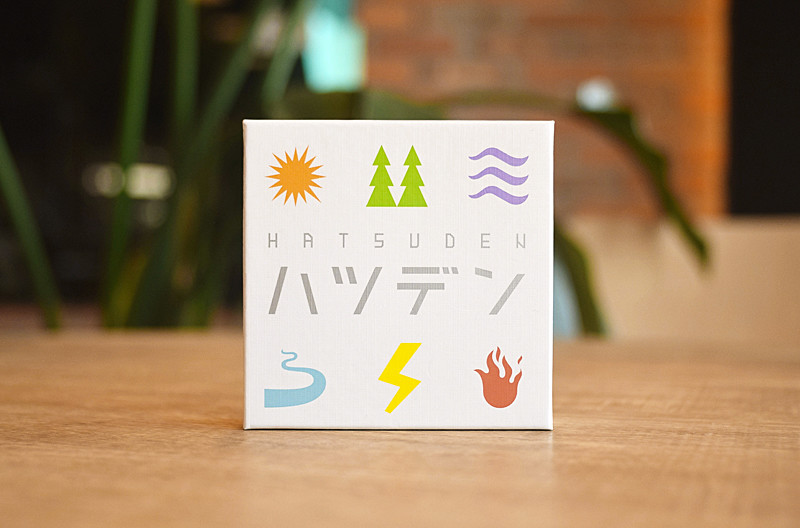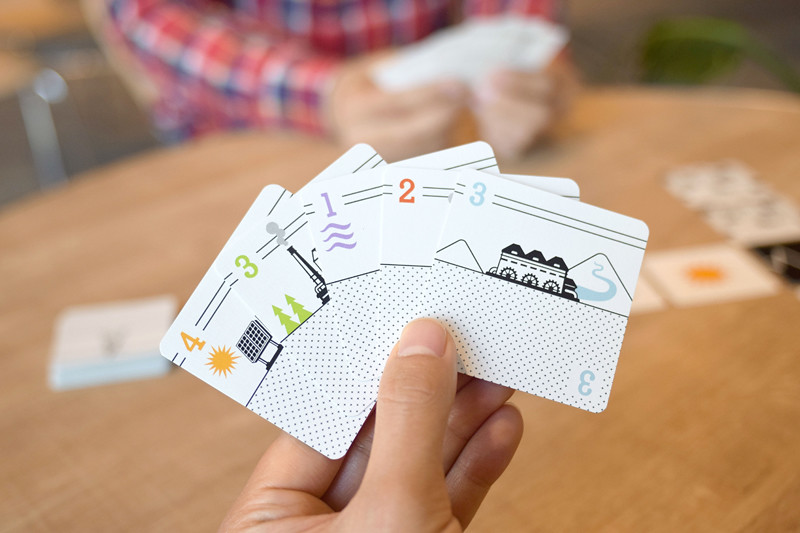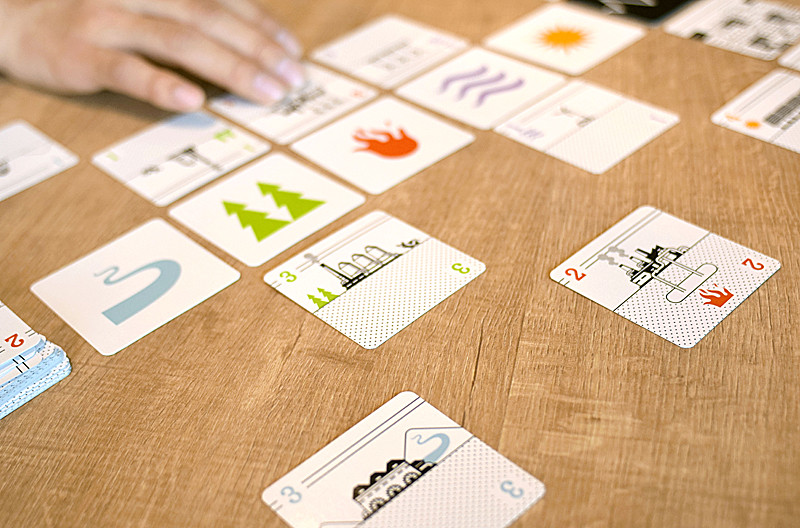The dawn of Spiel Essen 2018 is breaking. The mainstream publishers and designers from the USA and Europe will not be the only ones that come, but there will be some who are seeking attention from Asia. One of them would be itten, a board game company based in Japan. They have been getting attention since last year’s exhibition through their most wanted dexterity game ever, Tokyo Highway. Managed by Naotaka Shimamoto, Yoshiaki Tomioka, and Nozomi Obinata, itten has also published several other titles such as Hatsuden, one of its micro creations that we’ll talk about on this occasion.

A micro-review
Hatsuden is a portrayal of a typical board game designed by the Japanese. It is minimally designed, wrapped in a tiny size, yet concealing a stunning game inside. As a bonus, the game is fun, too.
The compact size makes Hatsuden an outstanding travellers’ companion to kill time during long journeys. Simple and easy to learn, it only takes 30 minutes to play a session with two players.
The theme is actually quite unique, and it needs an urgent discussion between all layers in our community, even within the board game fans as well. In Hatsuden, two players are competing to take control over five available sustainable energy resources: solar, biomass, wind, water, and geothermal. Each player must manage the electricity produced by all the resources and deliver it to the two cities while maintaining the optimal current.
It is easy to set up this game. You just have to place all five energy resources horizontally, followed by the two cities that you have to run the electricity through vertically. This setup will build a 5×2 playing area with 10 blocks for each player. Shuffle the power plant and technology cards separately and then set it on the side of the playing grid, making it easy for both players to draw cards.
On their first turn, each player will draw five cards from the deck. These cards consist of sets of number from level 1 to 4 for each sustainable resources. Each turn, players need to pick one out of the available actions:

- Construct a power plant by playing a card from hand to the space corresponding to energy resource.
- Power plant upgrade by placing a card with greater number or value over an existing card according to the responding energy resource.
- Construct pylons by playing a card face down. This is useful when you have delivered enough and optimal electricity.
- Revision of power line and scheme when players do not want to play any card. The player needs to discard a card from the hand to the discard pile.
When you put a level 4 card from any type to the playing area (through action no. 1 or 2), you can draw one special technology card, only while stock is available. These cards can help you to win the game by tweaking the rule during planing and scheming the electricity line. This action is ineligible when there’s no more special technology card left. In addition, when player takes the fourth action, the opponent may draw the face up cards from the discard pile.
There are three numbers printed on the city cards that represent the minimum, optimal, and maximum electricity tolerance supplied by the power plants. If the cards’ sum in a row reaches 11 or more, you must flip one of the power plant cards from this row to the pylon side. If at the end of the game the city gets under 9 points, the player receives a -1 point penalty.
The game ends when one player manages to fill all ten spaces. If you cannot complete your grid, then the rest must be filled with pylons. At the end of the game, each player calculates the points that he or she has gathered to decide the winner.
The points are gathered from each energy resource. Both rows on each column will be summed and compared, player with the higher number will receive the point from that energy resource. If there’s a tie, nobody gets the point. Player also receives point when the electricity on the same row is exactly at 10.
Opinion
When you catch a glimpse of the outside, Hatsuden offers an interesting minimalist design. The artwork on each card is kept at a minimum but with enough things to awe you. I also like how they designed the game with the square cards. Granted, that it is an unusual size, but it sure helped a lot to arrange the power grid. I really wish Saboteur would have implemented it in their game, too.

The theme is also unique, and should I say rather important. I really appreciated how itten tried to raise the urgency for public to pay more attention to renewable energy sources. With how the world has been going so far (in terms of energy resourcing), it has been pretty worrying. I think Hatsuden is a smart way to introduce this topic to more people in your circle. The background story Hatsuden brings is rather educative, an added bonus to a game that’s already decent.
From the mechanical side, Hatsuden is simple to play, but still requires enough complex strategy. Both players have to manage the cards in their hands and on the playing area to steal points. While drawing deck guarantees randomized outcome, Hatsuden is more strategy than tactical. Of course, players need to adapt to what they have in hands, but the risk of getting too high or too low can still be minimized through good planning and calculation. The presence of the technology cards adds richness to the strategies to gain points.
The top and bottom limitations (depicted by the electricity tolerance) demand players to be careful when arranging the cards they play. Too much electricity means you waste energy, and it leads to a shutdown on your power plant. Too low and your citizens will be discontent, making you lose points in the end. The ‘just about right’ philosophy dominated our gaming session with Hatsuden.
Verdict
Behind the complexity of the strategy, Hatsuden is still a micro game considerable for newcomers. It is easy to learn, and you will be willing to teach others to play, too. The game does not take long, making it possible to play Hatsuden as a filler. I am quite content with this game, especially because it accommodates two people.
I am a full-time food technologist during weekdays. However, when the calendar hits weekends, I transform into an avid board gamer. I am a hardcore Legend of the Five Rings (L5R) LCG player from Fantasy Flight Games (FFG). Current hobby: buying board games. My shelf of shame’s list is getting longer, thanks to you, Kickstarter.





